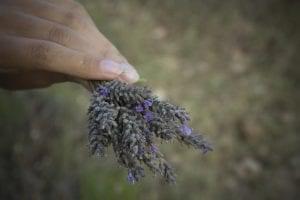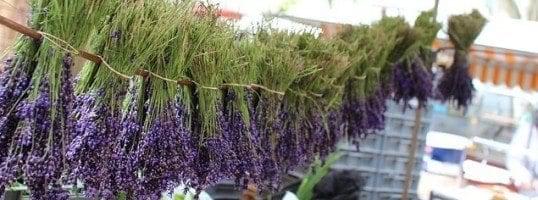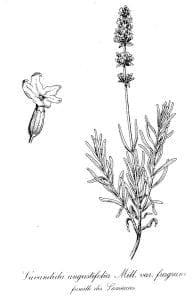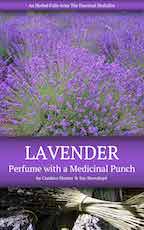Lavendula species or (L. angustifolia, L. vera, L. officinalis) – Mint family
a.k.a.: common lavender, true lavender, English lavender

Lavender’s versatility through the centuries has made it a consistent favorite. Today, its balsamic, earthy, floral scent is added to a variety of beauty and cleaning products for its disinfectant as well as its relaxation properties. It can ward off a variety of bacterias and viruses, including staph, while it calms the nervous system. Lavender soothes as it heals.
In the garden, lavender’s scent draws bees and butterflies alike with its promise of serenity. Lavender’s spiky blossoms offer important food for our winged friends. They draw us into the peace and quiet that nourishes soul-deep, too. No English garden would be complete without a representative of this powerful, gentle species.
Medicinal Properties of Lavender
As an herb, lavender is full of tannins. It has a strong astringent effect that shrinks inflamed tissue by drawing out extra mucus. This property lends itself to steams and soaks readily. The rare combination of antimicrobial properties, sedative effects, and tannic content brings lavender to the top of the list for bathwater favorites. To maximize the effect of the tannins in lavender, use its leaves as well. Lavender leaves contain 12 percent tannins.
Lavender essential oil is deeply aromatic. It has over 150 compounds packed into its volatile oils. The tannins in lavender are problematic for most people. They’re hard on the stomach and drying to the mouth. This is why most people favor lavender essential oil over the tincture. The essential oil has lavender’s antibacterial, antiviral, anti-fungal, anti-convulsive, sedative, and other medicinal properties squeezed into one condensed liquid.
Lavender essential oil’s scent is mostly due to its high levels of an alcohol–-linalool (28-49 percent) and an ester called linalyl acetate (12-45 percent). Lavender essential oil is chock full of healing constituents. The amount can vary depending on the lavender variety grown, the growing conditions and how it’s harvested. Primarily, lavender essential oil contains terpenes, alcohols, aldehydes, ketones, oxydes, esters, lactones, and cumarines. These chemicals blend into a highly therapeutic medicine.
Conditions Best Helped by Lavender
People and animals who experience extreme nervousness, particularly that which is rooted in feelings of overwhelm or over-stimulation, can be helped by flower essence of lavender. Lavender flower essence works to return the individual to a state of balanced spiritual sensitivity seated in the physical body by soothing the individual’s energy field and reminding the energetic self how to properly protect and moderate his or her boundaries. Those most in need of lavender flower essence are those who tend to absorb more energy, particularly spiritual/psychic energy, than they can truly handle. The results are often head complaints, such as headaches, neck or shoulder tension, or vision problems. This can also result in insomnia or addiction. Individuals who are helped by lavender flower essence may be described as high-strung.
Lavender flowers added to formulas designed to ease muscle tension, such as those for muscle strain and injury, help to improve circulation and quiet muscle spasm. Lavender’s cooling quality carries excess heat away from the injured area, thus reducing inflammation. Arthritis as well as a variety of muscle complaints are helped by lavender applied topically in the form of lavender-infused oils, tea or infusion of lavender flowers, or lavender essential oils.
Both topical and deep wounds are helped by timely application of lavender essential oil. In these situations, when you want to ensure infection has no chance to set in, you can apply lavender essential oil neat, or undiluted, directly to the wound. Lavender essential oil does not sting when applied to open wounds, making it a good first aid tool for adults and children alike.
Lavender’s antibacterial property allows it to set to work killing that bacteria which may have already entered the wound and preventing further bacteria from doing so. In addition, lavender’s anti-inflammatory properties help the tissues release excess heat and swelling, thus allowing the body to move nutrients and energy into the injured area to heal while better removing the toxins and byproducts of the healing process.
Lavender is effective against staphyloccus auerus infected wounds as well. Research supports lavender essential oil as a reliable treatment in the battle with MRSA. Simply applying a dressing with a few drops of lavender essential oil to an infected wound will cause clearing in a few days. Geranium and tree tree essential oils are perfect companions for this treatment.
Lavender essential oil is renowned for its ability to assist in recovery from burns. Lavender helps cool the burn site and reduce inflammation associated with burns. It doesn’t sting when applied, which is a godsend for those suffering from burns, particularly severe burns. It also helps keep the burned site clean, preventing bacteria from taking hold as the tissues rebuild. The antimicrobial properties also work to prevent scarring.
Lavender essential oil makes a great compress for treating bruises. Just soak a clean cotton cloth in cold water. Ring it out. Add a few drops of lavender essential oil and a teaspoon of witch hazel to the center of the cloth. Place the compress gently on the bruised area. Wrap the area in plastic or wool strips to keep the compress in place and to keep the unaffected areas from getting wet. Do not keep the compress in place for more than six hours. The compress may be rinsed and used again with fresh lavender essential oil and witch hazel.

For tension headaches, add lavender essential oil to your vaporizer or diffuser. Or, dab a drop on your temples and neck at your pulse points to help ease the tension that’s causing pain. Lavender essential oil has been shown to successfully treat some types of migraines. Keep in mind that it takes about 15-20 minutes for an essential oil, applied topically, to hit the blood stream. Be patient and let lavender’s soothing energies penetrate the pain then dispel it.
Lavender added to tea or to a sinus steam can help ease respiratory complaints including sinusitis, congestion and runny nose, sore throat, coughing, bronchitis, and other respiratory infections. A traditional Russian remedy for bronchitis is two drops of lavender essential oil mixed in a teaspoon of honey.
Lavender essential oil can help reduce the symptoms associated with addiction, particularly those resulting from the detox process. Lavender helps mitigate stress. The stress from detox is tremendous. Just a drop on the pulse points or in a diffuser reduces the panic from withdrawal markedly. Lavender is also an antispasmodic and antidepressant, which is helpful when working with the issues of addiction.
According to Robert Tisserand and other experts, there is no credible evidence to the suggestion put forth in a study published in The New England Journal of Medicine in 2007 that large amounts of lavender essential oil can cause prepubertal gynecomastia in boys or girls. If this is of concern to you, do further research and consider reducing the level of exposure to lavender essential oil your subject may be getting until you’ve determined the source of this condition. “Uterotrophic Assay of Percutaneous Lavender Oil in Immature Female Rats” by The International Journal of Toxicology may help.
For More Information on Lavender
For more information on Lavender, purchase a copy of The Practical Herbalist’s Herbal Folio: Lavender: Perfume with a Medicinal Punch. This Herbal Folio contains expanded information, including:
- Gardening and Gathering
- Animal Husbandry
- Household Formulas
- History, Folklore, Myth, and Magic
- Cautions
- Recipes
- A Printable Quick Facts Card
- References
Proceeds from sales of The Practical Herbalist’s Herbal Folio series go toward supporting The Practical Herbalist website. Support this terrific reference site by buying your copy of Lavender: Perfume with a Medicinal Punch today.









